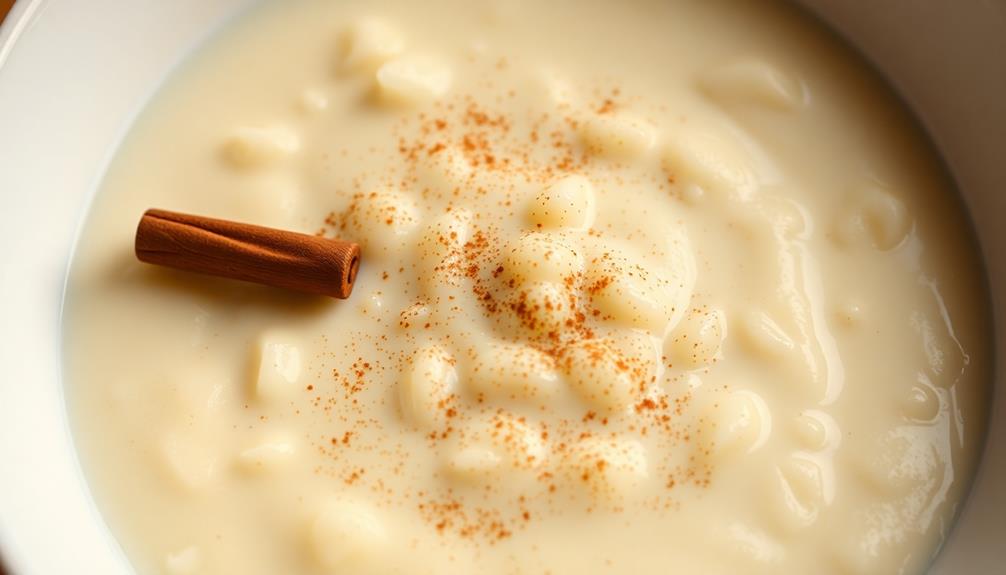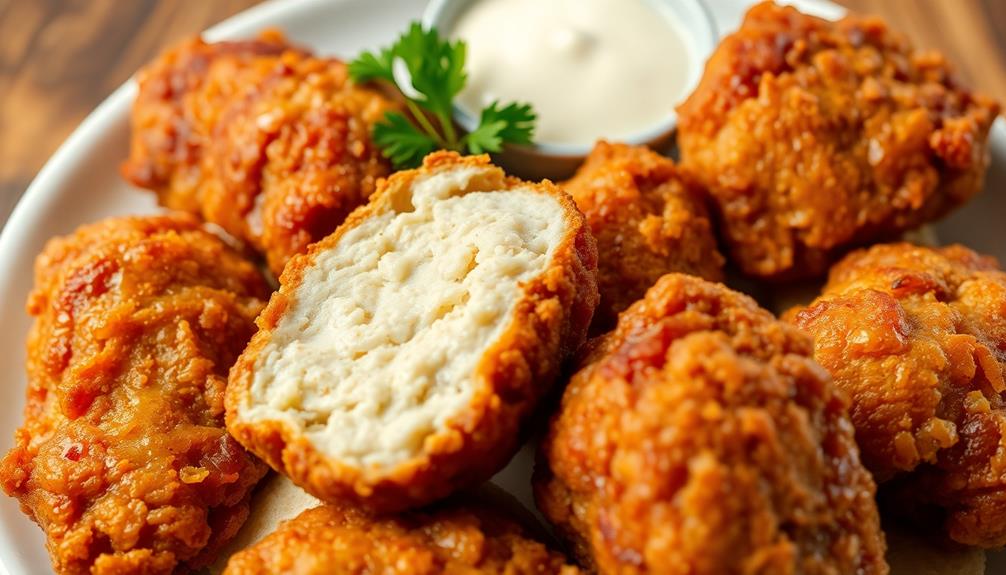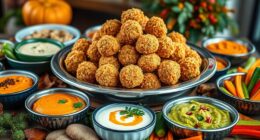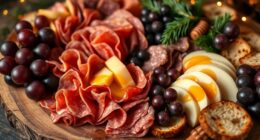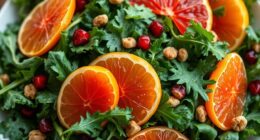Pancakes with maple syrup are a beloved breakfast classic that'll make your taste buds dance! You'll love the fluffy, golden rounds topped with warm, sweet syrup. To make them, mix dry ingredients like flour and baking powder, then combine with whisked eggs and milk. Pour the batter onto a hot griddle and watch for bubbles before flipping. Stack your perfect pancakes and drizzle with real maple syrup for the best flavor. You can add fun toppings like berries or chocolate chips too. This timeless treat isn't just for mornings – it's great any time of day! Discover the secrets to making your pancakes extra special.
Key Takeaways
- Pancakes with maple syrup combine fluffy, golden-brown cakes with sweet, flavorful syrup for a classic breakfast dish.
- Essential pancake ingredients include flour, eggs, milk, baking powder, and sugar, with a 1:1 flour-to-milk ratio.
- Cook pancakes on medium heat for 2-3 minutes per side, flipping when bubbles form on the surface.
- Warm maple syrup enhances flavor; pour over pancakes and add a pat of butter for richness.
- Customize pancakes with flavors like vanilla or cinnamon, and explore toppings such as berries or whipped cream.
History
Throughout history, pancakes have been a beloved breakfast staple in many cultures. You might be surprised to learn that they've been around for thousands of years! Ancient Greeks and Romans enjoyed flatbreads similar to pancakes, and they've been found in cookbooks dating back to the 1400s.
In North America, Native Americans were making pancakes from corn long before European settlers arrived. When the colonists came, they brought their own pancake recipes and started using local ingredients like cornmeal. As time went on, pancakes became a popular way to use up extra flour and eggs before Lent.
The addition of maple syrup to pancakes is a uniquely North American tradition. You can thank the Indigenous peoples for discovering how to tap maple trees and boil down the sap into sweet syrup. When European settlers learned this technique, they quickly adopted it and started pouring it over their pancakes.
Today, you'll find pancakes in many forms around the world. From French crêpes to Russian blini, each culture has put its own spin on this simple yet delicious dish.
Cooking Steps
The cooking process for perfect pancakes is straightforward but requires attention to detail. First, you'll want to mix your dry ingredients in a bowl. Combine flour, sugar, baking powder, and a pinch of salt.
In another bowl, whisk together milk, eggs, and melted butter. Now, pour the wet mixture into the dry ingredients and stir until just combined. Don't overmix, or your pancakes will be tough!
Heat up a non-stick pan or griddle over medium heat. When it's hot, add a small pat of butter and let it melt. Pour about 1/4 cup of batter for each pancake.
Watch for bubbles to form on the surface – that's your cue to flip! Cook the other side until it's golden brown.
Keep your pancakes warm in a low oven while you finish cooking the rest. When you're done, stack them high on a plate and drizzle with warm maple syrup.
You've just made a delicious breakfast that'll make everyone smile!
Step 1. Mix Dry Ingredients Together

Generally, the first step in making pancake batter is to mix the dry ingredients. You'll need a large mixing bowl to start. Grab your all-purpose flour, sugar, baking powder, and a pinch of salt. These are the key players in creating fluffy, delicious pancakes.
First, measure out your flour carefully. It's important to get the right amount for the perfect pancake texture. Next, add the sugar. This will give your pancakes a touch of sweetness.
Now, it's time for the baking powder. This magical ingredient is what makes your pancakes rise and become fluffy. Don't forget the salt! Just a small amount will enhance all the flavors.
Once you've added all these dry ingredients to your bowl, it's time to mix them together. Use a whisk or a fork to blend everything thoroughly. Make sure there aren't any lumps of flour or baking powder.
Stir it all together until it looks like a uniform, pale mixture. This well-mixed dry base will ensure your pancakes turn out just right!
Step 2. Mix Wet Ingredients Separately
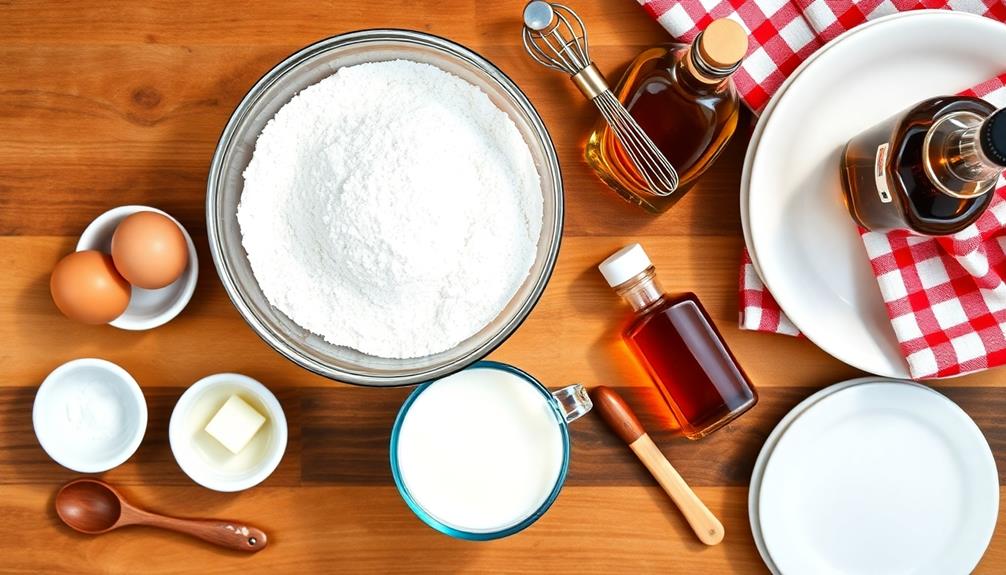
Now that you've prepared the dry ingredients, it's time to focus on the wet components of your pancake batter. You'll need a large bowl for this step.
First, crack two eggs into the bowl and whisk them until they're well beaten. Next, add 1 3/4 cups of milk to the eggs. If you want extra fluffy pancakes, you can use buttermilk instead of regular milk.
Now, it's time for the fun part! Pour in 1/4 cup of melted butter. Make sure it's not too hot, or it might cook the eggs. Now, gently whisk the butter into the mixture until well combined. This will help give the egg cream a rich and creamy texture. For a truly classic egg cream recipe, don’t forget to add a splash of vanilla extract and a sprinkle of nutmeg for that extra touch of flavor.
Add a teaspoon of vanilla extract for a delicious aroma and flavor. Whisk all these wet ingredients together until they're well combined.
You'll notice the mixture looks a bit frothy and has a pale yellow color. That's exactly what you want! The air bubbles you've created will help make your pancakes light and fluffy.
Once everything is mixed, set this bowl aside. You're now ready to combine the wet and dry ingredients to create your perfect pancake batter. Isn't cooking exciting?
Step 3. Combine Wet and Dry Mixtures
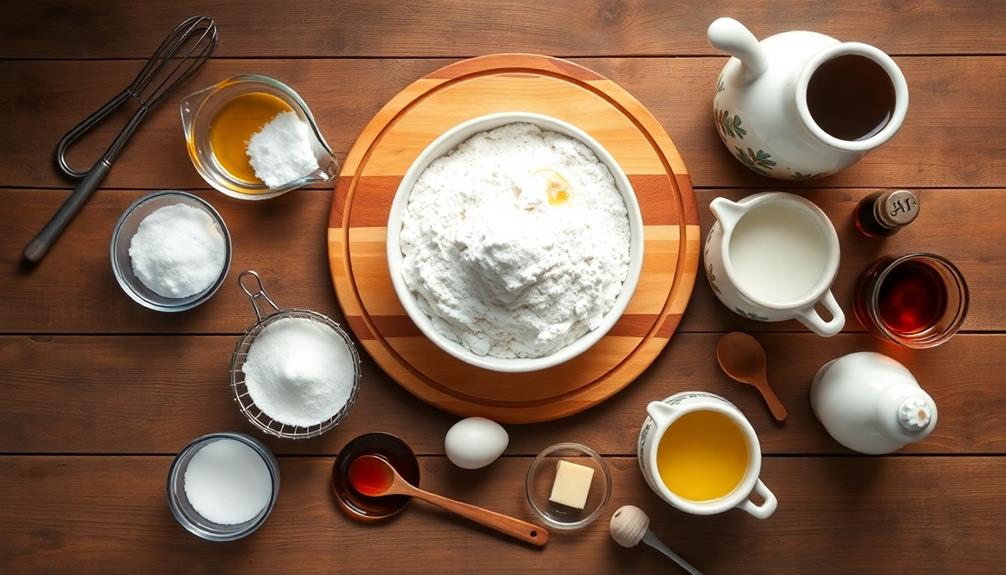
Combining wet and dry ingredients marks a crucial step in creating your pancake batter. It's time to bring everything together! Grab your bowl of dry ingredients and make a small well in the center. This little crater will help you mix everything more easily.
Now, pour your wet mixture into the well. Using a whisk or a large spoon, start stirring from the center. As you mix, gradually incorporate more of the dry ingredients from the sides. Keep stirring until you've got a smooth batter. Don't worry if you see a few small lumps – that's okay!
Be careful not to overmix. Too much stirring can make your pancakes tough. You'll want to stop when the batter is just combined. It should be thick but pourable, like heavy cream.
If your batter seems too thick, you can add a little more milk, about a tablespoon at a time. If it's too thin, sprinkle in some extra flour.
Step 4. Cook on Hot Griddle

The griddle-cooking process is where your pancake batter transforms into golden discs of deliciousness. First, make sure your griddle or non-stick pan is hot enough. Test it by sprinkling a few drops of water on the surface; if they sizzle and dance, you're ready to go!
Pour about 1/4 cup of batter onto the griddle for each pancake. You'll see tiny bubbles forming on the surface as it cooks. When the edges start to look dry, and the bubbles pop and leave little holes, it's time to flip! Slide your spatula underneath and give it a quick, confident turn.
The second side will cook faster, so keep an eye on it. You're looking for a beautiful golden-brown color on both sides. Don't be tempted to press down on the pancake with your spatula – this will make them flat and less fluffy.
Once they're done, stack them on a warm plate and cover with a clean kitchen towel to keep them hot. Now you're ready to serve up a pile of perfect pancakes!
Step 5. Serve With Warm Syrup

While your pancakes are staying warm, it's time to prepare the maple syrup. You'll want to heat it up to make it extra delicious.
Pour your desired amount of syrup into a microwave-safe container. Heat it in short bursts of 15-20 seconds, stirring between each interval. Be careful not to overheat it, as syrup can get very hot!
Once your syrup is warm, it's ready to serve. Take your plate of fluffy pancakes and place it on the table. Pour the warm syrup over the top, watching as it cascades down the sides. The aroma of maple will fill the air, making your mouth water.
For an extra special touch, you can add a pat of butter on top of the pancakes before pouring the syrup. It'll melt and mix with the syrup, creating a heavenly combination.
Don't forget to have some extra syrup on the side, just in case you want more. Now, grab your fork and knife, and get ready to enjoy your perfect stack of pancakes with warm, gooey maple syrup!
Final Thoughts
After enjoying a stack of fluffy pancakes drizzled with maple syrup, you'll understand why this classic breakfast combo has stood the test of time.
It's a perfect way to start your day, filling your home with the sweet aroma of golden, buttery goodness.
Remember, practice makes perfect when it comes to pancake-making. Don't be discouraged if your first few attempts aren't picture-perfect.
With time, you'll master the art of creating those perfectly round, golden-brown circles. Experiment with different toppings and flavors to keep things exciting.
Try adding fresh berries, chocolate chips, or even a dollop of whipped cream for extra indulgence.
Pancakes aren't just for breakfast, either. They make a great treat any time of day.
Whether you're cooking for yourself, your family, or a crowd, pancakes are sure to bring smiles to everyone's faces.
So grab your apron, fire up the griddle, and get ready to create some delicious memories.
With these tips and tricks, you're well on your way to becoming a pancake pro!
Frequently Asked Questions
Can I Substitute Maple Syrup With Other Sweeteners?
You can substitute maple syrup with other sweeteners. You'll find honey, agave nectar, or even fruit syrups work well. If you're looking for a low-calorie option, try sugar-free syrups. Each alternative will add its unique flavor to your dish.
How Long Can I Store Leftover Pancake Batter?
You can store leftover pancake batter in the fridge for up to 2 days. Make sure it's in an airtight container. For longer storage, freeze it for up to 3 months. Don't forget to mix well before using.
What's the Best Way to Keep Pancakes Warm Before Serving?
You can keep pancakes warm by placing them on a baking sheet in a 200°F oven. Don't stack them; instead, arrange them in a single layer. This method will keep them warm and crisp for up to 30 minutes.
Are There Gluten-Free Alternatives for Making Pancakes?
Yes, you can make delicious gluten-free pancakes! Try using alternative flours like almond, coconut, or rice flour. You'll also find pre-made gluten-free pancake mixes in stores. Don't forget to add xanthan gum for better texture.
How Do I Prevent My Pancakes From Becoming Soggy?
To prevent soggy pancakes, you'll want to cook them at the right temperature and avoid overcooking. Don't stack them while hot; instead, serve immediately or keep warm on a wire rack in a low oven until ready to eat.




